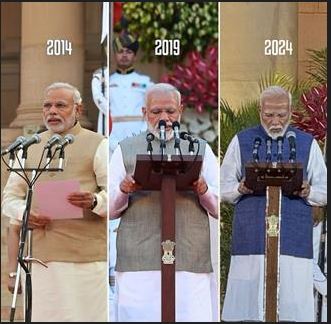PM Modi’s Historic Third Term Begins: A New Era for India
Narendra Modi begins his historic third term as India's Prime Minister with a diverse 72-member Cabinet, signalling a blend of continuity and change in the nation's leadership.
Narendra Modi, the charismatic leader of the Bharatiya Janata Party (BJP), has taken the oath as the Prime Minister of India for a third consecutive term. This historic event at the Rashtrapati Bhavan in New Delhi marks a rare political feat only previously achieved by Pandit Jawaharlal Nehru. Alongside Modi, a 72-member Cabinet, reflecting continuity and change, was unveiled, promising to steer India through the next five years with renewed vigour.
Prime Minister of India for a third consecutive term. This historic event at the Rashtrapati Bhavan in New Delhi marks a rare political feat only previously achieved by Pandit Jawaharlal Nehru. Alongside Modi, a 72-member Cabinet, reflecting continuity and change, was unveiled, promising to steer India through the next five years with renewed vigour.
Historic Milestone and a Diverse Cabinet
Modi’s third term is significant not only for its historical precedent but also for the breadth and diversity of his Cabinet. The 72-member team includes 30 Cabinet Ministers, 5 Ministers with independent charge, and 36 Ministers of State. This mix balances experience with fresh perspectives as the government navigates complex domestic and international landscapes.
President Droupadi Murmu administered the oath, with senior leaders Rajnath Singh, Amit Shah, Nitin Gadkari, and JP Nadda among the first to be sworn in. These seasoned politicians bring continuity to Modi’s administration, each having played pivotal roles in previous terms. Notably, Rajnath Singh, Amit Shah, and Nirmala Sitharaman, who held key portfolios in the last government, will continue to shape defense, home affairs, and finance, respectively.
Electoral Dynamics and Coalition Strength
The BJP’s performance in the recent elections was formidable, winning 240 seats. However, it fell 32 seats short of a majority in the 543-member Lok Sabha. This shortfall was mitigated by the support of allies in the National Democratic Alliance (NDA), which collectively secured 293 seats. The coalition’s strength underscores Modi’s ability to maintain and expand political alliances, crucial for legislative efficacy.
The Cabinet features six former chief ministers: Rajnath Singh, Shivraj Singh Chouhan, Manohar Lal Khattar, HD Kumaraswamy, Jitan Ram Manjhi, and Sarbananda Sonowal. Their inclusion highlights the emphasis on experience and regional representation, ensuring that diverse state interests are addressed nationally.
Notable Inclusions and Exclusions
Amit Shah retains his influential role, likely continuing as Home Minister, while S. Jaishankar, the former diplomat, is expected to guide India’s foreign policy. The return of veterans like Piyush Goyal, Dharmendra Pradhan, and Jyotiraditya Scindia signals stability and continuity in key economic and infrastructural portfolios.
However, the exclusion of high-profile leaders such as Smriti Irani, Rajeev Chandrasekhar, and Anurag Thakur has raised eyebrows. Their absence suggests strategic recalibrations within the party and the government’s priorities for the coming term.
The induction of George Kurian from Kerala signifies the BJP’s outreach to minorities and its efforts to expand its footprint in the state. Additionally, Suresh Gopi, who became the first Lok Sabha Member elected from Kerala, has also been inducted into Modi’s government.
The Cabinet also showcases significant representation from BJP allies. HD Kumaraswamy of the Janata Dal (Secular) and Lalan Singh from the Janata Dal (United) were among the first allies to take the oath, emphasizing the NDA’s broad coalition base. Leaders like Chandrababu Naidu (TDP), Chirag Paswan (LJP), and Eknath Shinde (Shiv Sena) further illustrate the inclusive approach Modi has adopted.
Celebrated Attendance and Political Overtones
The oath-taking ceremony was a grand affair, attended by approximately 8,000 guests, including leaders from neighbouring countries like Bangladesh, Sri Lanka, the Maldives, Bhutan, Nepal, Mauritius, and Seychelles. This international presence underscores India’s strategic regional importance and Modi’s diplomatic outreach.
Prominent Indian figures, including Congress President Mallikarjun Kharge, attended the ceremony. Kharge’s attendance, despite opposition parties’ general boycott, underscores his role as the Leader of the Opposition in the Rajya Sabha and reflects the democratic ethos of Indian politics. Conversely, the absence of leaders from parties like the Trinamool Congress and the Left was noted, highlighting the prevailing political discord.
Celebrities like Rajinikanth, Shah Rukh Khan, Akshay Kumar, and Anupam Kher were also present, adding a touch of glamour and symbolizing the intersection of politics and popular culture in India.
As Narendra Modi embarks on his third term, the challenges are manifold. The economy, foreign policy, social harmony, and regional dynamics require deft handling. The diverse and experienced Cabinet is a strategic mix to address these challenges. With allies firmly on board and a clear mandate from the electorate, Modi’s government is poised to implement its vision for India’s future.
Supporters and critics will keenly watch as India navigates its path under Narendra Modi’s continued leadership. The new Cabinet, reflecting continuity and change, will play a crucial role in shaping the country’s trajectory over the next five years.
